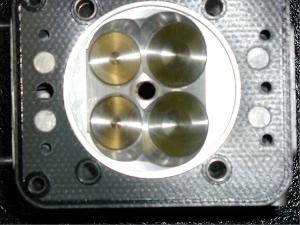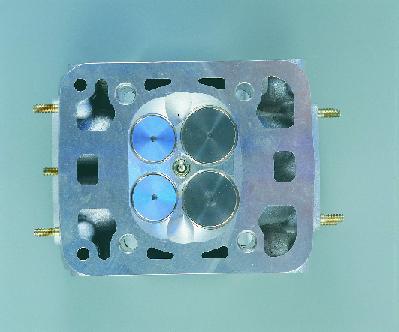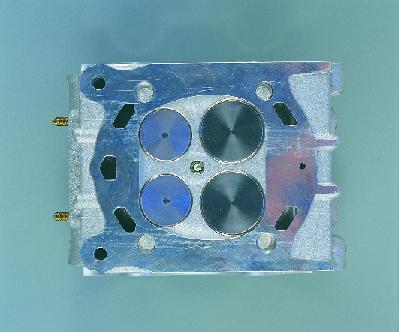
Ducati's new Superbike engine, the 'Testastretta'.
The new 4-valve heads have 40mm inlet valves the same size as a Suzuki TL1000R street-bike. Not in itself too amazing, except that, the 916 has had 33mm inlets and the 996 has been getting by with 36mm inlet valves. Although the 'factory' Corsa bikes have pushed the valve size to the limit of the design, they have still been drastically limited in inlet valve size since c1993.
Though there has been a gradual increase in bore-stroke ratio over recent years (and much written of it), the valve-area-to-bore-area relationship is a major factor in an engines ability to produce power.
Ducati Superbikes have been successfully using 5400 FPM mean piston speeds (at 12,500 RPM) which is well above the traditional 4500-4800 FPM 'endurance engine' criteria. The shortened stroke will allow them an extra 500 RPM (492 RPM to be a more precise) for the same mean piston speed.
Mean piston speed isn't all there is to making horsepower. Despite shortening the stroke, which nets higher RPM for the same piston speed, it takes a higher valve-to-bore area ratio to support power production at higher RPMs. Thus, the need for new head/valves.
A Little History
The first example of the present line of 4 valve engines was a 748cc engine. It was built (1985?) on 750 2-valve crankcases, since the 900SS/851 crankcase wasn't in production yet. (Probably in the design stages.)
The 750cc 2-valve engine has had bore-stroke dimensions of 88mm X 61.5mm (the same dim. as the present 748 and M750.) This was stretched from the original 500 Pantah (of 1979), which was 74mm X 58mm.
It's not clear why 748cc (88mm bore) was chosen except for the existence of the TT f1 endurance racing class, which Ducati had been able to win several times. During the same time period, Ducati were already increasing the displacement of their air-cooled 748cc engine to 817cc by increasing the bore to 92mm, then 851cc by stroking it to 64mm, for Battle-of-the-Twins racing which was gaining popularity at that time.
For what-ever- reason, the valve placement was established on the 88mm bore. A 748 can handle 36mm inlet valves (the size of the inlet valves on the 748RS) which will be just short of touching the bore. The V-to-B-area ratio of the 748RS engine is 0.3347:1. (36mm inlet valves and 88mm bore.) (See the spreadsheet later in this article.)

Above is photo of a Pro-Thunder (800cc) Ducati head with 35mm inlets. With an 88mm (748) head gasket.
The 748RS valve sizes are 1mm larger than the valves in the photo above. You can see why that is about the limit.
This does maximize the use of the combustion chamber for the 748 engine.
Now look at a stock 916 combustion chamber with a stock 94mm head gasket.

You can see that the 33mm inlet valves could be much larger and still not be close to the cylinder wall.
In addition, the inlets are crowded so close to the exhausts that they have always limited lift at overlap.
In the early '90s the Ducati Superbike cams increased in lift and duration until they reached the limit of valve size and valve-to-valve contact at overlap.
The 'G' cams have the longest duration and earliest inlet opening of any of the race cams. Since then, Ducati have gone to later inlet opening and larger inlet valves, chasing the inlet-to-exhaust valve clearance problem.

Above is a photo of a combustion chamber of 96mm bore (926cc & 955cc) with 37mm inlet valves. This represents the valve and bore sizes of the 1993-94 (926 and 955, respectively) World Superbike engines and the 1996 916SP (which was a 955cc engine.)
There are rumors of the 'factory' bikes having offset valve guides. This would help by moving the valves farther from there respective partners, thus improving flow. Rocker-arm geometry sets the amount of inlet-to-exhaust clearance (on overlap) so none of that can be gained with offset guides.
The 996 (below), which has 36mm inlet valves, has lots of room between it's 36mm inlet valves and the edge of the bore.

The 98mm bore of the 996 creates a chamber that is quite wide with significant squish area (another impediment to ultra high RPM).
When the bore is increased by 10mm, from 88mm to 98mm (for the 996) that leaves 5mm more for valve radius increase, (that would allow slightly larger than 46mm inlet) except the valve center-to-center distance is 41mm . That dimension allows a maximum inlet valve diameter of 41mm if you don't leave any room for aluminum between the inlet valve seats. (This can be done, but cylinder head cracking is inevitably the result.)
Even if valves that big could be used, the flow would be compromised by the valves touching one another, which shrouds the flow area between them.

Even with the increased 100mm bore the new heads utilize the bore area more efficiently. The flatter valve angle and greater distance between the inlets and the exhausts allows more lift at overlap without the valves hitting one another.
Are the ports too big?
The mean-port-velocity equation commonly used (which is, simply, a geometric velocity equation, based on mean piston velocity and the port to bore area relationship) ignores some significant losses in high-piston-speed and high RPM engines. But that's another subject all by itself.
The fact is that modern high-output engines need all of the valve area they can get, to make power at high RPM.
As piston speeds and/or RPM go up, an engine needs a higher valve-area- to-bore-area ratio to maintain volumetric efficiency.
The Testastretta engine falls into that 'high piston speed', 'high RPM' category.
Below is a spreadsheet showing the V-to-B area ratio of some of these engines, and a few others for comparison.
The entries in the spreadsheet are sorted in ascending order of their valve-to-bore area ratio. You can see that the 916 has less valve area than a Chevy V-8 with a 2" inlet valve and 4" bore.
The 2000 GSXR-750 represents the latest trends in hi-rev technology. I'm not sure what size valves the Suzuki Superbikes use, but it could be 30mm which puts it as the highest V-to-B area ratio of the bunch.
If Ducati use 41mm inlets on the 'Testastretta', that makes it a little higher than the 748RS. That's appropriate, since the 748RS is 'just a street bike'.
Considering how severely limited in valve area the Ducati engines have been, it's clear that they have worked near-miracles keeping that engine competitive. Now it remains to be seen how well they can handle the right stuff.